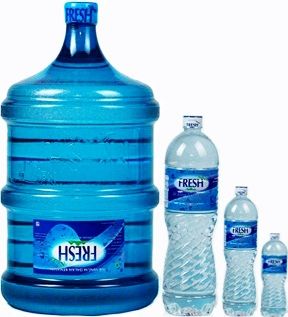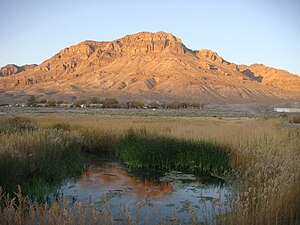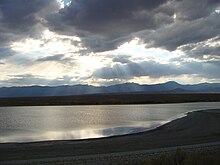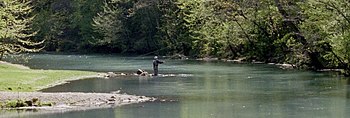A spring—also known as a rising or resurgence—is a component of the hydrosphere. Specifically, it is any natural situation where water flows to the surface of the earth from underground. Thus, a spring is a site where the aquifer surface meets the ground surface.
Formation
A spring may be the result of karst topography where surface water has infiltrated the Earth's surface (recharge area), becoming part of the area groundwater. The groundwater then travels through a network of cracks and fissures—openings ranging from intergranular spaces to large caves. The water eventually emerges from below the surface, in the form of a karst spring.
The forcing of the spring to the surface can be the result of a confined aquifer in which the recharge area of the spring water table rests at a higher elevation than that of the outlet. Spring water forced to the surface by elevated sources are artesian wells. This is possible even if the outlet is in the form of a 300-foot-deep (91 m) cave. In this case the cave is used like a hose by the higher elevated recharge area of groundwater to exit through the lower elevation opening.
Non-artesian springs may simply flow from a higher elevation through the earth to a lower elevation and exit in the form of a spring, using the ground like a drainage pipe.
Still other springs are the result of pressure from an underground source in the earth, in the form of volcanic activity. The result can be water at elevated temperature such as a hot spring.
The action of the groundwater continually dissolves permeable bedrock such as limestone and dolomite creating vast cave systems.
Types of spring outlets
- Seepage or filtration spring. The term seep refers to springs with small flow rates in which the source water has filtered into permeable earth.
- Fracture springs, discharge from faults, joints, or fissures in the earth, in which springs have followed a natural course of voids or weaknesses in the bedrock.
- Tubular springs are essentially water dissolved and created underground channels, basically cave systems.
Flow
Spring discharge, or resurgence, is determined by the spring's recharge basin. Factors that affect the recharge include the size of the area in which groundwater is captured, the amount of precipitation, the size of capture points, and the size of the spring outlet. Water may leak into the underground system from many sources including permeable earth, sinkholes, and losing streams. In some cases entire creeks seemingly disappear as the water sinks into the ground via the stream bed. Grand Gulf State Park in Missouri is an example of an entire creek vanishing into the groundwater system. The water emerges nine miles (14 km) away, forming some of the discharge of Mammoth Spring in Arkansas. Human activity may also affect a spring's discharge-withdraw of groundwater reduces the water pressure in an aquifer, decreasing the volume of flow.
Classification
Springs are often classified by the volume of the water they discharge. The largest springs are called "first-magnitude," defined as springs that discharge water at a rate of at least 2800 liters or 100 cubic feet (2.8 m3) of water per second. Some locations contain many first-magnitude springs, such as Florida where there are at least 27 known to be that size; the Missouri and Arkansas Ozarks, which contain (10 known of first-magnitude); and 11 more in the Thousand Springs area along the Snake River in Idaho.
The scale for spring flow is as follows:
| Magnitude | Flow (ft³/s, gal/min, pint/min) | Flow (L/s) |
|---|---|---|
| 1st magnitude | > 100 ft³/s | 2800 L/s |
| 2nd magnitude | 10 to 100 ft³/s | 280 to 2800 L/s |
| 3rd magnitude | 1 to 10 ft³/s | 28 to 280 L/s |
| 4th magnitude | 100 US gal/min to 1 ft³/s (448 US gal/min) | 6.3 to 28 L/s |
| 5th magnitude | 10 to 100 gal/min | 0.63 to 6.3 L/s |
| 6th magnitude | 1 to 10 gal/min | 63 to 630 mL/s |
| 7th magnitude | 1 pint to 1 gal/min | 8 to 63 mL/s |
| 8th magnitude | Less than 1 pint/min | 8 mL/s |
| 0 magnitude | no flow (sites of past/historic flow) |
Water content
Minerals become dissolved in the water as it moves through the underground rocks. This may give the water flavour and even carbon dioxide bubbles, depending on the nature of the geology through which it passes. This is why spring water is often bottled and sold as mineral water, although the term is often the subject of deceptive advertising. Springs that contain significant amounts of minerals are sometimes called 'mineral springs'. Springs that contain large amounts of dissolved sodium salts, mostly sodium carbonate, are called 'soda springs'. Many resorts have developed around mineral springs and are known as spa towns.
Water from springs are usually clear. However some springs may be coloured by the minerals that are dissolved in the water. Iron and tannins often give spring water an orange colour.
A stream carrying the outflow of a spring to a nearby primary stream is called a spring branch or run. Groundwater tends to maintain a relatively long-term average temperature of its aquifer; so flow from a spring may be cooler than a summer day, but remain unfrozen in the winter. The cool water of a spring and its branch may harbour species such as certain trout that are otherwise ill-suited to a warmer local climate.
Historic uses
Springs have been used for a variety of human needs including drinking water, powering of mills, and navigation, and more recently some have been used for electricity generation.
Sacred springs
A sacred spring, or holy well, is a small body of water emerging from underground and revered either in a pagan or a Christian context, often both. The lore and mythology of ancient Greece was replete with sacred and storied springs—notably, the Corycian, Pierian and Castalian. In medieval Europe, holy wells were frequently pagan sacred sites that later became Christianized. The term "holy well" is commonly employed to refer to any water source of limited size (i.e. not a lake or river, but including pools and natural springs and seeps), which has some significance in the folklore of the local area. This can take the form of a particular name, an associated legend, the attribution of healing qualities to the water through the numinous presence of its guardian spirit or Christian saint, or a ceremony or ritual centred on the well site. In Christian legend, the spring water is often said to have been made to flow by the action of a saint, a familiar theme especially in the hagiography of Celtic saints.
Modern uses
Present-day uses include recreational activities, such as trout-fishing, swimming, and floating. The water is also used for livestock and fish hatcheries


.jpg)





.jpg)


.jpg)
.jpg)
.jpg)
.jpg)
.jpg)
.jpg)
.jpg)

